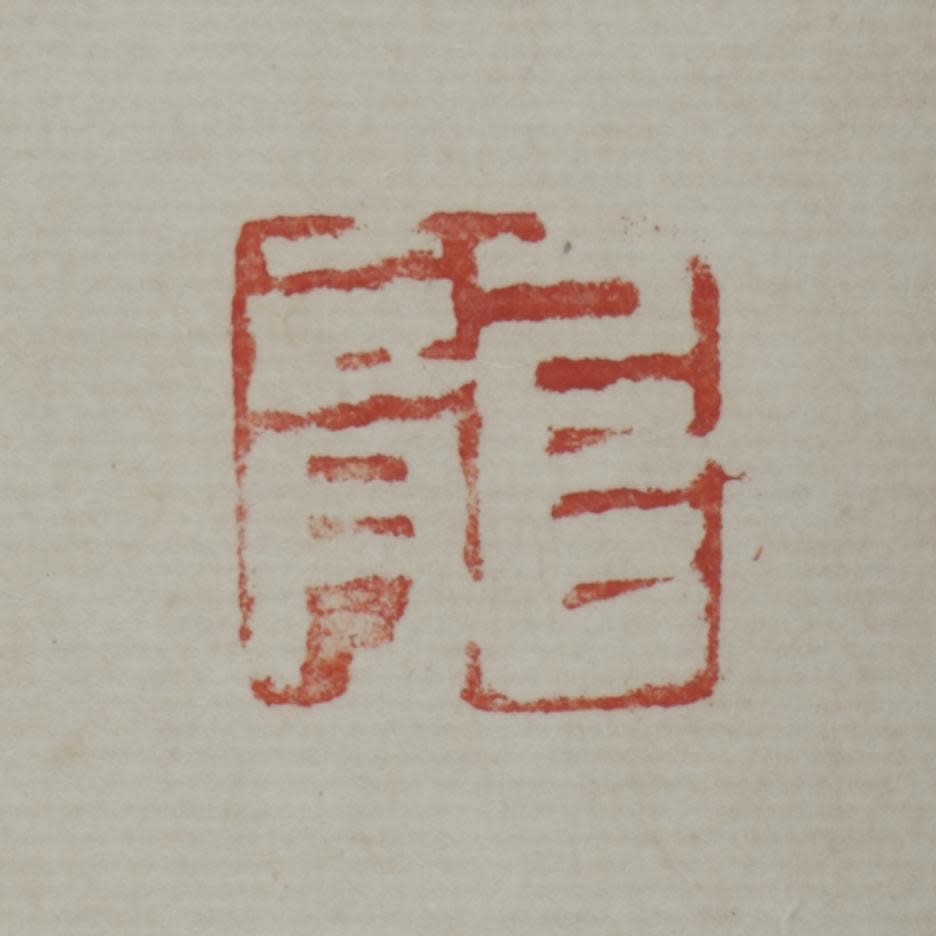Morita Shiryū (1912–1998)
Nin
Ink on paper, framed
1975
With a label signed by Inada Sousai
Seal: Ryu
14.8 x 20.3 cm
17 x 23 cm (overall)
1975
With a label signed by Inada Sousai
Seal: Ryu
14.8 x 20.3 cm
17 x 23 cm (overall)
Literature
Morita Shiryu Catalogue Raisonné: 1952–1998. Uji: Soryusha, 2019.
Among the works of the 18th-century Zen master Hakuin Ekaku, there are various hanging scrolls that center on a large depiction of the character nin, with an inscription expounding its meaning written in smaller script around it. In the special edition on Hakuin in Bokubi, Morita recalled having considered Hakuin’s scrolls when planning his own version of Nin. His interpretation of the character differed from Hakuin’s, as he would explain below:
To achieve a profound understanding of the human condition
and yet to adhere to the precepts and one’s vows of austerity (carya) is
one of the highest-regarded attainments in Buddhist thought.
Those who understand the destitution of existence while trying to break from it
thus are deserving of deepest admiration.
(“Sho and the Human.” Bokujin 330, 1986)
On a different occasion, Morita stated:
While writing, I am blessed with the opportunity to improve and renew myself.
I realized that if I become one with the brush, one with the characters,
I will achieve a more wholesome version of myself.
Therefore what matters is not just to become more skillful at writing,
but to fully realize my purpose in life. The idea represented with nin is something
I feel I am never able to exhaust, as much as I would try.
That’s why I keep writing it.
(“In Conversation with Hokkaido Bokujin Members,” Bokujin 319, 1985)
The work is small enough to fit into one’s two hands, yet it feels charged with significance. Nin was one of the characters that Morita concentrated on in his seventies, reflecting on its meaning in the light of his own maturation. Once a certain state of mind was reached, he was able to process it into writing. This was perhaps how Nin came into being.
Morita Shiryu (avant-garde calligrapher; 1912–1998)
Avant-garde calligrapher from Hyogo Prefecture. Like fellow artist Inoue Yuichi, Morita studied under the calligraphy master Ueda Sokyu. He co-founded the avant-garde group Bokujinkai together with Inoue and was the founder and editor of the journal Bokubi (Beauty of Ink), both of which revolutionized traditional Japanese calligraphy and spread knowledge of Japanese avant-garde calligraphy to an international audience. He was posthumously awarded the Medal of Honor with Dark Blue Ribbon.
To achieve a profound understanding of the human condition
and yet to adhere to the precepts and one’s vows of austerity (carya) is
one of the highest-regarded attainments in Buddhist thought.
Those who understand the destitution of existence while trying to break from it
thus are deserving of deepest admiration.
(“Sho and the Human.” Bokujin 330, 1986)
On a different occasion, Morita stated:
While writing, I am blessed with the opportunity to improve and renew myself.
I realized that if I become one with the brush, one with the characters,
I will achieve a more wholesome version of myself.
Therefore what matters is not just to become more skillful at writing,
but to fully realize my purpose in life. The idea represented with nin is something
I feel I am never able to exhaust, as much as I would try.
That’s why I keep writing it.
(“In Conversation with Hokkaido Bokujin Members,” Bokujin 319, 1985)
The work is small enough to fit into one’s two hands, yet it feels charged with significance. Nin was one of the characters that Morita concentrated on in his seventies, reflecting on its meaning in the light of his own maturation. Once a certain state of mind was reached, he was able to process it into writing. This was perhaps how Nin came into being.
Morita Shiryu (avant-garde calligrapher; 1912–1998)
Avant-garde calligrapher from Hyogo Prefecture. Like fellow artist Inoue Yuichi, Morita studied under the calligraphy master Ueda Sokyu. He co-founded the avant-garde group Bokujinkai together with Inoue and was the founder and editor of the journal Bokubi (Beauty of Ink), both of which revolutionized traditional Japanese calligraphy and spread knowledge of Japanese avant-garde calligraphy to an international audience. He was posthumously awarded the Medal of Honor with Dark Blue Ribbon.



